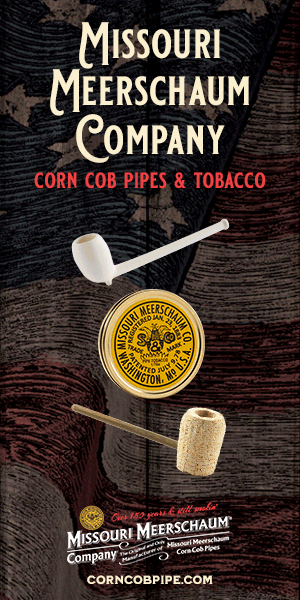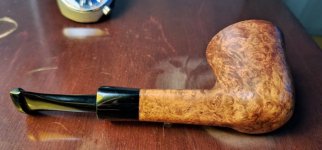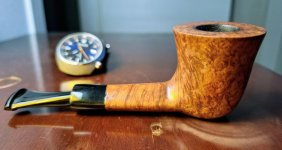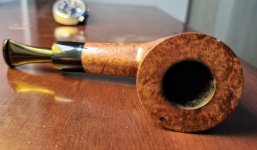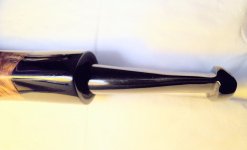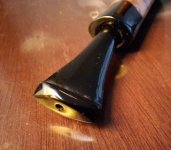Being his fellow citizen, I am lucky enough to personally know Alessandro Corsellini, the third and last descendant of a dynasty of pipemakers born in the second half of the 19th century (initially as restorers and pipe sellers, then as artisan producers).
However, I had never owned one of his creations, so, during a recent dinner with other passionate friends, I took the opportunity to buy - at a very favorable price - one of his pipes (see photo).
His style is quite free and imaginative, not really suited to my tastes; this one I bought was perhaps the most sober, it is made with a very sweet Calabrian briar that amazed me with its goodness from the first smoke. Unfortunately - Alessandro told me - Calabrian briar often has defects and impurities (mine has two obvious pits) and for this reason he has recently abandoned it in favor of Tuscan briar.
The stem has two particularities: it is very generous in thickness and this makes it uncomfortable to hold in the mouth; I had also thought about giving it back to him to reduce its thickness, but then I decided it was better to keep it like this, as his father had thought of it and given birth to it.
The second peculiarity is in the stem hole which does not have the classic horizontal cut (see photo) but simply a hole. According to Corsellini, the carving in the stem - over time - collects the tar from smoking and releases bad flavors. Personally, I have never noticed this type of inconvenience, in any case, when smoking, you do not notice the difference and the smoke spreads in your mouth exactly like in all other stems.
A final personal consideration: I have been frequenting various pipe smoking forums for 10 years and I have had the opportunity to learn a lot about this hobby, also by reading the opinions of many expert smokers. However - allow me - when you talk to a craftsman who was born and raised among briar logs, you notice the difference.
Notes on the author
 pipedia.org
pipedia.org
However, I had never owned one of his creations, so, during a recent dinner with other passionate friends, I took the opportunity to buy - at a very favorable price - one of his pipes (see photo).
His style is quite free and imaginative, not really suited to my tastes; this one I bought was perhaps the most sober, it is made with a very sweet Calabrian briar that amazed me with its goodness from the first smoke. Unfortunately - Alessandro told me - Calabrian briar often has defects and impurities (mine has two obvious pits) and for this reason he has recently abandoned it in favor of Tuscan briar.
The stem has two particularities: it is very generous in thickness and this makes it uncomfortable to hold in the mouth; I had also thought about giving it back to him to reduce its thickness, but then I decided it was better to keep it like this, as his father had thought of it and given birth to it.
The second peculiarity is in the stem hole which does not have the classic horizontal cut (see photo) but simply a hole. According to Corsellini, the carving in the stem - over time - collects the tar from smoking and releases bad flavors. Personally, I have never noticed this type of inconvenience, in any case, when smoking, you do not notice the difference and the smoke spreads in your mouth exactly like in all other stems.
A final personal consideration: I have been frequenting various pipe smoking forums for 10 years and I have had the opportunity to learn a lot about this hobby, also by reading the opinions of many expert smokers. However - allow me - when you talk to a craftsman who was born and raised among briar logs, you notice the difference.
Notes on the author






